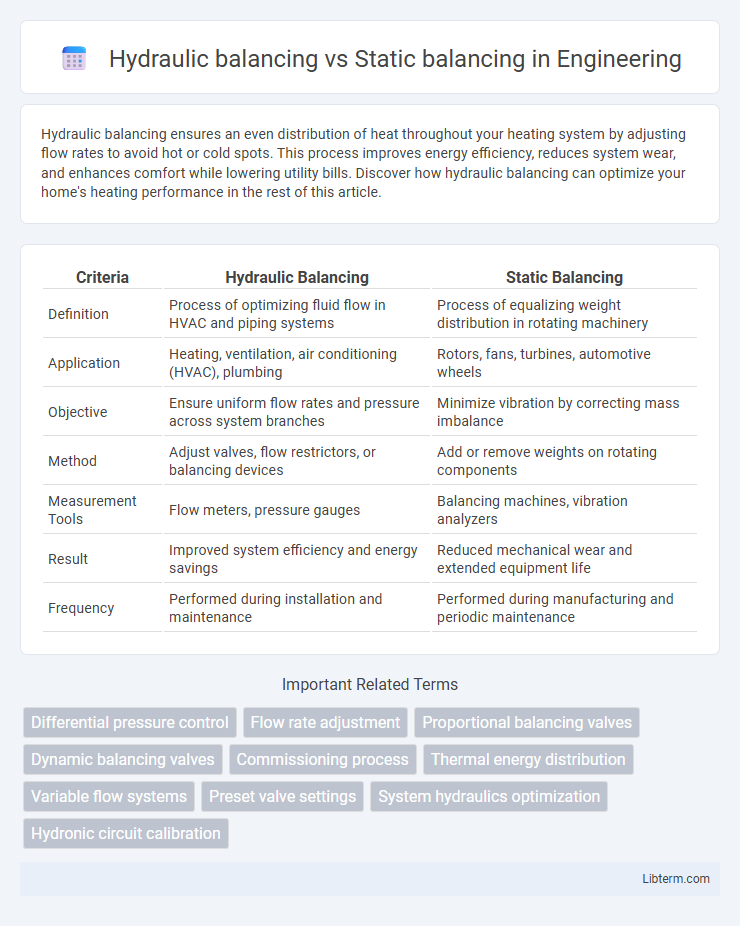Hydraulic balancing ensures an even distribution of heat throughout your heating system by adjusting flow rates to avoid hot or cold spots. This process improves energy efficiency, reduces system wear, and enhances comfort while lowering utility bills. Discover how hydraulic balancing can optimize your home's heating performance in the rest of this article.
Table of Comparison
| Criteria | Hydraulic Balancing | Static Balancing |
|---|---|---|
| Definition | Process of optimizing fluid flow in HVAC and piping systems | Process of equalizing weight distribution in rotating machinery |
| Application | Heating, ventilation, air conditioning (HVAC), plumbing | Rotors, fans, turbines, automotive wheels |
| Objective | Ensure uniform flow rates and pressure across system branches | Minimize vibration by correcting mass imbalance |
| Method | Adjust valves, flow restrictors, or balancing devices | Add or remove weights on rotating components |
| Measurement Tools | Flow meters, pressure gauges | Balancing machines, vibration analyzers |
| Result | Improved system efficiency and energy savings | Reduced mechanical wear and extended equipment life |
| Frequency | Performed during installation and maintenance | Performed during manufacturing and periodic maintenance |
Introduction to Hydraulic and Static Balancing
Hydraulic balancing ensures equal distribution of water flow in heating and cooling systems by adjusting valve settings to optimize efficiency and comfort. Static balancing involves physically adjusting or installing weights on rotating machinery to eliminate vibration caused by mass imbalances. Understanding hydraulic balancing improves system energy performance, while static balancing primarily enhances mechanical stability and prolongs equipment lifespan.
What is Hydraulic Balancing?
Hydraulic balancing involves adjusting flow rates in heating or cooling systems to ensure equal distribution of fluid, optimizing energy efficiency and system performance. It targets the dynamic pressure differences within the piping network, unlike static balancing which only considers static pressure. Hydraulic balancing improves comfort, reduces energy consumption, and prevents issues like noise and uneven temperature distribution.
What is Static Balancing?
Static balancing refers to the process of ensuring that the weight of a rotating component is evenly distributed around its axis of rotation to prevent vibration during operation. It involves placing the component on a fixed point or bearing and adding or removing weight until it remains stationary without rotation due to imbalance. Unlike hydraulic balancing which manages fluid flow and pressure in piping systems, static balancing specifically addresses mechanical equilibrium in rotating parts such as fans, rotors, and turbines.
Key Differences between Hydraulic and Static Balancing
Hydraulic balancing ensures even distribution of water flow in heating or cooling systems, optimizing energy efficiency and comfort by adjusting flow rates dynamically based on system demand. Static balancing involves setting fixed flow rates using manual valves or preset settings without accounting for real-time changes in system pressure or temperature. The key difference lies in hydraulic balancing's dynamic adjustment capability versus static balancing's fixed configuration, impacting system performance and energy savings.
Importance of Balancing in HVAC Systems
Hydraulic balancing in HVAC systems ensures even distribution of water flow across all circuits, preventing energy waste and maintaining optimal system performance. Static balancing adjusts airflow at fixed points, but lacks adaptability to fluctuating system demands, potentially causing inefficiencies. Proper balancing minimizes energy consumption, enhances comfort levels, and extends equipment lifespan by avoiding overworking pumps and fans.
Advantages of Hydraulic Balancing
Hydraulic balancing improves energy efficiency by ensuring even distribution of fluid flow across all system components, reducing pump energy consumption and minimizing operational costs. It enhances system comfort and reliability by maintaining consistent temperatures and pressures, preventing overheating or underheating in heating and cooling systems. Unlike static balancing, hydraulic balancing adapts dynamically to system changes and varying loads, providing optimal performance in real-time conditions.
Advantages of Static Balancing
Static balancing offers advantages in simplicity and cost-effectiveness, as it requires fewer components and less maintenance compared to hydraulic balancing. It effectively ensures the even distribution of fluid flow in systems with relatively stable loads, reducing energy consumption and preventing system overpressure. Static balancing is particularly beneficial in HVAC systems and piping networks where flow rates remain consistent, improving overall system efficiency without complex adjustments.
Common Applications for Each Balancing Method
Hydraulic balancing is commonly applied in HVAC systems, district heating, and cooling networks to optimize fluid flow distribution and energy efficiency by adjusting valve settings dynamically. Static balancing is typically used in rotating machinery such as turbines, fans, and compressors to minimize vibration and wear by correcting mass distribution on rotor assemblies. Each method targets distinct performance improvements: hydraulic balancing ensures even pressure and flow, while static balancing enhances mechanical stability and longevity.
Costs and Efficiency Comparison
Hydraulic balancing improves system efficiency by ensuring equal flow distribution, reducing energy consumption and operational costs over time, while static balancing is a one-time adjustment that may lead to less precise flow control and potential energy waste. Although static balancing involves lower initial costs due to simpler installation, it can result in higher long-term expenses caused by inefficient system performance and increased maintenance needs. Investing in hydraulic balancing usually offers better cost-effectiveness through optimized energy savings and enhanced system reliability.
Choosing the Right Balancing Method for Your System
Choosing the right balancing method depends on your system's requirements for accuracy and operational conditions. Hydraulic balancing ensures precise water flow distribution in heating or cooling systems by adjusting dynamic flow rates, making it ideal for variable load environments. Static balancing is simpler, focusing on fixed flow rates and pressure settings, suitable for smaller or less complex systems with consistent demand patterns.
Hydraulic balancing Infographic

 libterm.com
libterm.com